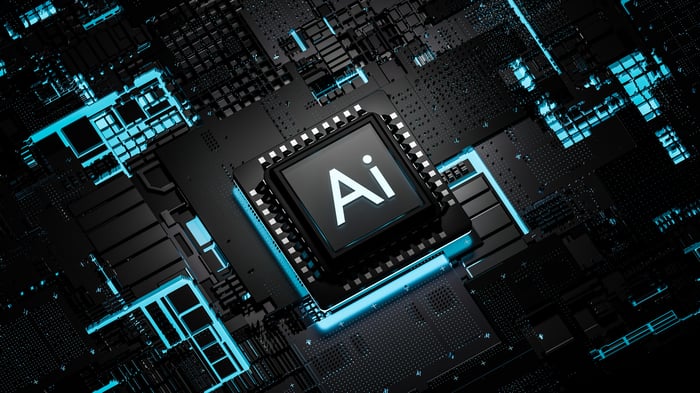Semiconductor companies are the beating heart of the artificial intelligence (AI) revolution. Investors need only look to Nvidia for proof: Its stock price has nearly tripled this year, as tech giants race to get their hands on its data center chips designed for AI workloads.
But that demand is just heating up. Nvidia CEO Jensen Huang says there is $1 trillion worth of existing data center infrastructure that needs upgrading to support accelerated computing and AI.
Since estimates suggest AI could add anywhere from $13 trillion to $200 trillion to the global economy by 2030, companies will likely continue spending billions on semiconductor hardware every year. Picking winners and losers won't be easy, though. Nvidia might be at the front of the pack now, but it won't be the only game in town forever.
There is one simple way investors can own a cross section of the entire chip industry, and remove the risk associated with owning individual stocks.

Image source: Getty Images.
An ETF might be the best choice for most investors
An exchange-traded fund (ETF) is a listed security that investors can buy in the same way they buy an individual stock. However, an ETF holds an entire portfolio of securities designed to give investors exposure to a specific sector of the market.
The iShares Semiconductor ETF (SOXX -0.26%) owns shares in 30 different chip companies, offering investors broad coverage over the entire semiconductor sector. The ETF has delivered a gain of 33% so far in 2023, which trounces the 13% return of the S&P 500 index.
It's unlikely to deliver such a hefty outperformance every year, but its historical returns suggest it could turn a $300 monthly investment into a million-dollar fortune over the long term.
The iShares Semiconductor ETF holds the most popular chip stocks
The iShares Semiconductor ETF holds just about every chip stock an investor would want to own, including the biggest names in artificial intelligence (AI) like Advanced Micro Devices and Nvidia. It also holds some of the key fabricators like Taiwan Semiconductor, and small service providers like Axcelis Technologies.
The ETF is very top-heavy because its five largest holdings account for more than 36% of the entire value of its portfolio:
|
Stock |
iShares Semiconductor ETF Weighting |
|---|---|
|
1. Advanced Micro Devices (AMD) |
8.02% |
|
2. Broadcom |
7.72% |
|
3. Nvidia |
7.33% |
|
4. Intel |
6.77% |
|
5. Texas Instrument |
6.55% |
Source: BlackRock. Holdings are as of Sept. 24 and are subject to change.
Top-heaviness creates a potential risk because if holdings like AMD and Nvidia suffer a steep drop in value, they could have a disproportionate downside impact on the entire ETF. On the other hand, the incredible run in Nvidia stock this year has helped the ETF deliver such a strong outperformance over the S&P 500.
In short, while this ETF does present a much safer way to expose your portfolio to the semiconductor space thanks to its diverse holdings, it's not risk free. But you could be very well compensated for that risk over time.
How investing $300 a month in this ETF could make you a millionaire
The iShares Semiconductor ETF was established in 2001, and it has delivered a compound annual return of 10.6% since then. But there are two sides to that story.
Between 2001 and 2013, owning this ETF would have yielded a loss! But in the 10 years since then, it has grown at an impressive compound annual rate of 24.6% -- more than double the average annual return of the S&P 500 index over the same period.
Its post-2013 growth explosion was driven by the rapid adoption of cloud computing, which helps businesses run their operations online through centralized data centers that rely on powerful semiconductors.
The ETF currently trades at a price of $459, so investors could set aside $300 per month and deploy $900 (on average) every three months. If the ETF continues to return 24.6% per year, that $900 quarterly investment would be worth north of $1 million in about 18 years. But if its average annual return moderates back to 10.6%, it would take about 33 years instead.
In any case, the iShares Semiconductor ETF could be an especially great buy for younger investors between the ages of 20 and 30, as part of a diversified portfolio. They have the most income-earning years ahead, and therefore they could be best positioned to capitalize on the long-term growth in demand for chips thanks to new technologies like AI.





